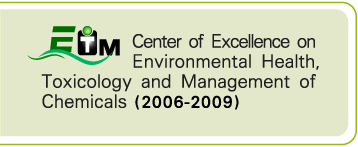|
Acrylamide, a neurotoxicant and suspected human carcinogen has been first discovered in foods by the Swedish researchers. Numerous paths of formation have been discussed, predominantly through a Maillard reaction and can be regarded as the most important heat-induced contaminants occurring in starchy foods. In addition, some reports suggested that acrylamide could form in lipid-rich foods by the acrolein precursor. Many researchers have confirmed the presence of acrylamide in different processed foods, but no intensive information is available for Thai-conventional foods. Considering of consumer health protection, a study was conducted to determine the acrylamide contamination in Thai-conventional foods samplings from Nong Mon Market, the most visited tourist attractions in Eastern part of Thailand. The GC/MS system was selected for analysis with a linear response ranged of 5-50 µg and r2 >0.99. The limit of detection (s/n = 3) and limit of quantification (s/n = 10) of the system were 4 and 15 µg kg-1, respectively, and RSD was < 2%. Acrylamide in 19 food samples ranged from < 15 µg kg-1 to 1.26 mg kg-1 with highest concentrations in Kanom Jak (grilled sweet coconut meal-rice paste wrapped in palm leaf). Moderate levels (150 – 500 µg kg-1) were detected mostly in deep-fried products, especially sweet potato and taro crisps, Kanom Kai Nok Ka Ta (deep-fried pre-gelatinized sweet potato ball), banana fritters, durian chips and spring rolls. Thai-conventional foods possessed low concentrations (<150 µg kg-1) including Khao Larm (grilled sweet rice with coconut milk packed in bamboo), Pa Tong Koo (deep-fried twisted wheat dough-roll, Chinese Style), sweet banana crisps and deep-fried Chinese wonton. Acrylamide was lowest (<15 µg kg-1) in fish strips, rice crackers, fried fishballs and Hoi Jor (deep fried minced pork and crabmeat balls wrapped in Tofu sheets). Dietary habits by 400 tourists indicate a daily intake of acrylamide <150 nanograms, well below a toxic dose. Monitoring of the stability of acrylamide contaminant in Pa Tong Koo under condition of in vitro digestion showed that 48.45% of acrylamide was adsorbed in intestinal tract. An attempt to develop the cooking method for reduction of browning (acrylamide formation) in Kanom Kai Nok Ka Ta was performed. The results found that using glycine as pre-gelatin of Kanom Kai Nok Ka Ta promoted the formation of dark brown color which was considered as off-color while CaCl2 enhanced the texture of the products. However, the acrylamide contents extracted from the obtained products did not show significance reduction when CMC containing glycine and CaCl2 was used as pre-gelatin. แหล่งข้อมูล:
|
 Center of Excellence on Environmental Health and Toxicology (EHT)
Center of Excellence on Environmental Health and Toxicology (EHT)










